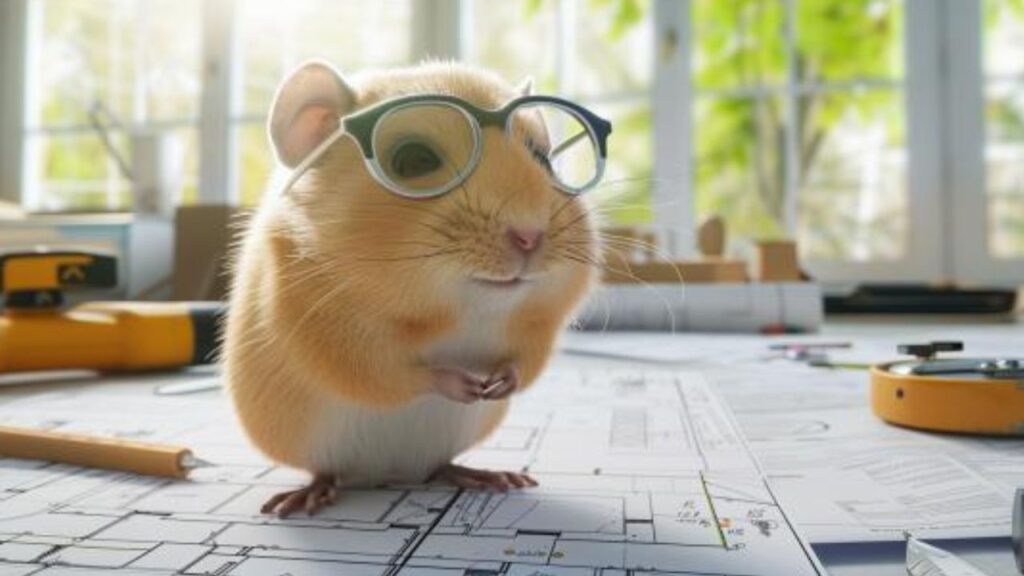Hello, fellow hamster enthusiasts! Dr. Vivian Whiskerson here, your guide to the fascinating world of hamsters. Today, we’re diving into a topic that has perplexed many a hamster parent: Hamster Houdinis. These tiny escape artists can squeeze through the smallest of gaps, turning your home into their adventure playground. But why do they do it, and more importantly, how can we lovingly curb their escape tendencies? Let’s explore.
Understanding Your Hamster’s Wanderlust
Why do these tiny creatures, whom we provide with food, shelter, and love, seek to venture beyond the safety of their homes? It’s not a simple case of ‘the grass is always greener on the other side’; rather, it’s an ingrained survival instinct. Hamsters in the wild are explorers and foragers by nature, traveling miles in a single night in search of sustenance and shelter. This instinctual behavior doesn’t fade, even in the comfort of a domestic setting. Recognizing this natural tendency is key to addressing the root cause of their escape attempts.
Creating a Hamster Haven
The solution isn’t to lock them down more tightly, but to enrich their environment in a way that satisfies their curiosity and need for exploration. Think of their cage not just as a place to live, but as a world to explore. By understanding the ‘why’ behind their Houdini-like tendencies, we can focus on creating a ‘hamster haven’ that offers them the stimulation and variety they crave. This involves not just the physical setup of their habitat but also how we interact with them, providing a mix of enrichment activities that cater to their natural behaviors.
Understanding the Escape Artist

Navigating the world of hamster escapology requires a deep dive into the reasons behind their Houdini-like tendencies, recognizing the warning signs, and understanding the psychology driving their behavior. Let’s unravel the mystery of our furry escape artists.
Why Hamsters Escape
- Instinctual Wanderlust: At the heart of every hamster escape is a powerful instinctual drive. These creatures are born explorers, hardwired to roam vast distances in search of food, mates, and territory in the wild. This natural wanderlust doesn’t vanish in captivity; instead, it often manifests as a restless quest for adventure beyond the confines of their cage.
- Seeking Stimulation: Hamsters require constant mental and physical stimulation, which a static environment can’t always provide. Their escape attempts are often a quest for new sights, smells, and textures, a break from the monotony of cage life. It’s their way of seeking out the excitement and challenges their environment lacks.
- Inadequate Space: Even the most well-intentioned hamster habitats can fall short of meeting their space needs. A small or overcrowded cage can trigger a hamster’s escape behavior, driven by the need for more territory to explore and claim as their own.
Signs Your Hamster Might Be Planning an Escape
- Night-time Reconnaissance: Hamsters are nocturnal, and a sudden spike in night-time activity, especially near potential exit points, can be a precursor to an escape attempt. They’re mapping their surroundings, identifying weak spots in their enclosure.
- Bar Gnawing and Digging: Persistent gnawing on cage bars or excessive digging, especially near the cage’s corners and base, can indicate a hamster’s growing frustration with their confinement and a desire to break free.
- Escape Practice: Yes, hamsters do practice their escape routines! You might notice them climbing more frequently, hanging from the roof of their cage, or even attempting to leap from one point to another. It’s not just play; it’s preparation for the big breakout.
The Psychology Behind the Escape
- A Quest for Freedom: The drive to escape is more than just physical; it’s deeply psychological. Hamsters are not just seeking physical space but autonomy, the ability to make choices about where to go and what to do. This quest for freedom is a powerful motivator behind their escape attempts.
- Stress and Anxiety Relief: For some hamsters, escaping is a way to relieve stress and anxiety. A crowded or noisy environment, lack of enrichment, or even too much or too little handling can lead to stress, prompting them to seek a way out. Escaping provides a temporary escape from the stressors of cage life.
- The Thrill of the Chase: Lastly, don’t underestimate the simple thrill of the chase. The act of escaping and being pursued can be exciting for a hamster, a break from the everyday routine. This doesn’t mean they want to leave you; they’re just indulging in a bit of mischievous fun.
Understanding why hamsters escape, recognizing the signs, and appreciating the psychology behind their behavior are crucial steps in creating a fulfilling environment that meets their needs and keeps their escape artist tendencies in check. Remember, a happy hamster is a wheel-y happy you, and understanding their escapology is the first step toward ensuring their happiness and safety.
Designing the Great Escape-Proof Habitat

Creating a habitat that satisfies your hamster’s needs while keeping them safely contained is an art form. It’s about blending security with enrichment to ensure your furry friend has no desire to leave their home. Here, we’ll explore how to choose the right cage, provide essential enrichment activities, and maintain a habitat that’s both engaging and escape-proof.
Choosing the Right Cage
- Size Matters: The first rule of thumb in preventing escapes is to provide ample space. A cage that’s too small can lead to stress and encourage escape attempts. For Syrian hamsters, a minimum of 620 square inches of continuous floor space is recommended, while dwarf hamsters thrive in at least 340 square inches. Bigger is always better, offering more room for exercise, toys, and exploration.
- Secure Construction: The cage’s build quality can make or break its escape-proof rating. Ensure the cage has a secure locking mechanism and that doors or lids cannot be easily manipulated by tiny paws. For wire cages, bar spacing should be no more than 0.5 inches apart to prevent squeezing through. Aquariums or terrariums with mesh lids can also be excellent choices, provided the lid fits snugly and is securely fastened.
- Consider the Layout: Multi-level cages with platforms and ramps add variety and enrichment to your hamster’s life. However, ensure that these features don’t inadvertently provide a stepping stone to escape. Check that your hamster cannot leap from the highest platform to the top of the cage or climb in a way that would allow them to bypass barriers.
Essential Enrichment Activities
- Toys and Wheels: A bored hamster is an escape artist waiting to happen. Toys, especially chew toys, and an appropriately-sized exercise wheel, are essential for mental stimulation and physical health. These not only entertain but also help wear down their ever-growing teeth.
- Tunnels and Hideouts: Hamsters have a natural instinct to burrow and hide. Offering tunnels, tubes, and hideouts can satisfy this urge, providing a sense of security and reducing stress. Ensure these are made of safe, chewable materials and are large enough to prevent stuck situations.
- Interactive and Foraging Toys: Stimulate your hamster’s intellect and foraging instincts with puzzle toys and treat-dispensing gadgets. These activities mimic the challenges they would face in the wild, keeping their mind engaged and focused inward, rather than on escaping.
Regular Habitat Maintenance
- Cleanliness is Key: A clean cage is a happy cage. Regular cleaning, at least once a week, prevents unpleasant odors and the buildup of harmful bacteria. A clean environment reduces stress and health issues, making the cage a more pleasant place to be.
- Inspect and Repair: During your cleaning routine, inspect the cage for any potential escape routes or damage. Look for chewed areas, loose bars, or gaps that may have widened over time. Promptly repairing any issues can prevent future escapes.
- Update and Rotate: To keep the environment fresh and engaging, regularly rotate toys and change the layout of the cage. This simple step can reignite your hamster’s interest in their surroundings, making the familiar new again and reducing the allure of the world beyond their cage.
By focusing on these three key areas, you can create a secure and stimulating environment that meets your hamster’s needs, reducing their desire to escape. Remember, an engaged and happy hamster is less likely to seek adventure elsewhere, making your job as a hamster parent that much easier.
Training Your Hamster to Love Their Home

Creating a living space that your hamster loves and feels secure in goes beyond physical environment adjustments—it also involves behavioral training and emotional support. Through establishing a routine, utilizing positive reinforcement techniques, and recognizing as well as addressing stress signals, you can make your hamster’s cage not just a house, but a home they adore and feel safe in. Let’s delve into how you can achieve this.
Establishing Routine
- Consistency is Comfort: Hamsters, much like humans, find comfort in predictability. Establishing a consistent daily routine helps reduce anxiety and provides a sense of security. This includes regular feeding times, play sessions, and quiet times. Once a hamster knows what to expect and when they can relax and enjoy their environment more fully.
- Sleep-Wake Cycle Respect: Understanding and respecting your hamster’s nocturnal nature is crucial. Schedule interaction and playtime during the evening when they are naturally more active and awake. Disturbing them during the day can cause stress and reluctance to engage with you, making them view their home as a place of unwanted disturbances.
- Handling with Care: Gradually introduce handling sessions to build trust and comfort. Start with short periods and gradually increase as your hamster becomes more accustomed to your presence and touch. This not only strengthens your bond but also makes them associate their home with positive, safe interactions.
Positive Reinforcement Techniques
- Rewards and Treats: Use treats to reward your hamster for desired behaviors, such as returning to their cage after playtime or allowing themselves to be handled without fuss. This reinforces the idea that good things happen within their home environment.
- Interactive Play: Engage with your hamster in ways that stimulate their mind and body—this can include puzzle toys that reward them with treats or gentle, hands-on play. Such interactions within their cage highlight it as a source of fun and engagement.
- Gradual Exposure: If your hamster seems reluctant to engage with certain aspects of their cage (like a new toy or area), use treats to gradually introduce them to the unfamiliar. This can help them overcome fear or hesitation, associating new experiences with positive outcomes.
Recognizing and Addressing Stress Signals
- Behavioral Cues: Pay close attention to your hamster’s behavior for signs of stress or discomfort, such as excessive hiding, biting, or avoidance of certain cage areas. These cues can indicate something in their environment is causing them distress.
- Physical Signs: Stress can also manifest physically, through symptoms like fur loss, changes in eating or drinking habits, or sudden aggression. Recognizing these early allows you to address issues before they escalate.
- Environmental Adjustments: If you notice signs of stress, review your hamster’s environment and routine for potential causes. This might mean adjusting something in their habitat, changing their diet, or altering your handling practices. Sometimes, the solution is as simple as providing more hiding spaces or ensuring they have a quiet, undisturbed rest area.
Training your hamster to love their home is a process of building trust, ensuring comfort, and creating a stimulating environment that caters to their natural behaviors. By establishing a routine, using positive reinforcement, and being attuned to their needs and stress signals, you can develop a deep bond with your hamster and ensure they view their cage as a safe, beloved haven.
Advanced Security Measures

Even with the best escape-proof habitat, the ingenuity of a determined hamster should never be underestimated. To further safeguard your furry Houdini, let’s explore additional layers of security measures, from escape-proofing your room to leveraging technology and crafting a solid recovery plan for when escapes happen.
Escape-Proofing Your Room
- Securing Potential Exit Points: Begin by identifying and securing all potential escape routes in the room. This includes sealing gaps under doors, covering ventilation grates, and ensuring windows are securely screened. Remember, hamsters can squeeze through surprisingly small spaces, so leave no gap unchecked.
- Safe Exploration Spaces: Create a hamster-safe exploration area within the room for supervised playtime. This area should be free of hazardous materials, electrical cords, and small objects that could be ingested. Use playpens or cardboard barriers to define this space, ensuring there are no escape routes.
- Supervised Free Roam Time: Allow your hamster out of their cage daily for supervised exploration and exercise. This not only satisfies their curiosity and need for exercise but also strengthens your bond. Keep doors closed, and block off unsafe areas to ensure their roaming is safe and contained.
Technology to the Rescue
- Surveillance Cameras: Consider installing a small, pet-safe surveillance camera near your hamster’s cage. These cameras can alert you to escape attempts in real-time, allowing for quick intervention. Plus, they offer the added benefit of letting you observe your hamster’s behavior when you’re not around, providing insights into potential stressors or boredom.
- Motion Detectors: Motion detectors can be set up around the cage or room to alert you if your hamster manages to escape. These devices can be especially useful during the night, providing peace of mind that any nocturnal adventures will be promptly noticed.
- Smart Cages: The market is beginning to see the introduction of smart cages equipped with escape alerts, automatic locking mechanisms, and environmental monitoring. These high-tech solutions offer an additional layer of security, ensuring that your hamster’s home is as safe and comfortable as possible.
When Escapes Happen: The Recovery Plan
- Calm and Systematic Approach: If your hamster does escape, remain calm. Panic can drive them into hiding or further away. Close all doors to contain the area and gently search common hiding spots, using a flashlight to check under furniture and in dark corners.
- Luring Them Back Safely: Place their favorite treats, water, and familiar objects from their cage in the center of the room to entice them back. You can also set up a humane trap using a bucket and a ramp, baiting it with food. Often, they will return on their own when it’s quiet, and they feel safe.
- Preventing Future Escapes: Once your hamster is safely recovered, carefully analyze how they escaped and take immediate steps to prevent a recurrence. This might involve upgrading the cage, reevaluating the room’s security, or adjusting your handling and care routines.
By implementing these advanced security measures, you can greatly reduce the likelihood of escapes and ensure a quick, safe recovery should your hamster decide to embark on an unsanctioned adventure. Remember, preparation and proactive measures are key to keeping your hamster safe, secure, and happily exploring within bounds.





